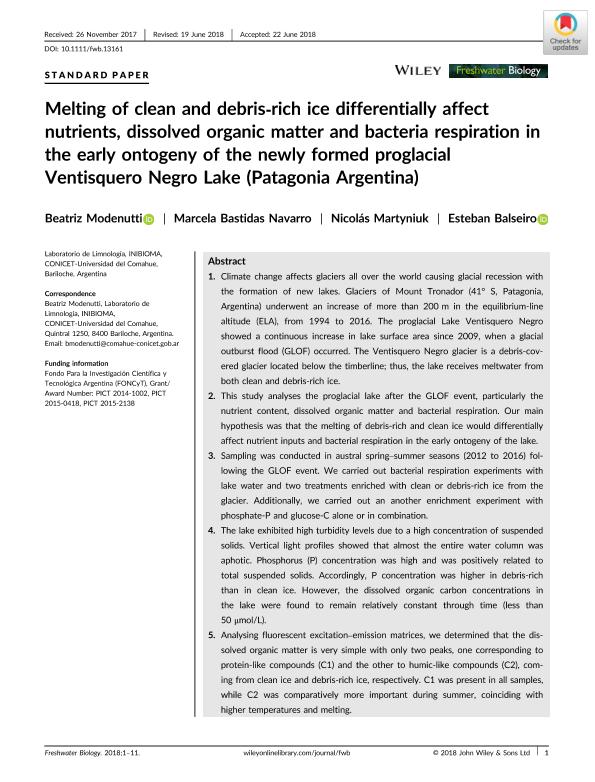Artículo
Melting of clean and debris-rich ice differentially affect nutrients, dissolved organic matter and bacteria respiration in the early ontogeny of the newly formed proglacial Ventisquero Negro Lake (Patagonia Argentina)
Modenutti, Beatriz Estela ; Bastidas Navarro, Marcela Alejandra
; Bastidas Navarro, Marcela Alejandra ; Martyniuk, Nicolás Alejandro
; Martyniuk, Nicolás Alejandro ; Balseiro, Esteban Gabriel
; Balseiro, Esteban Gabriel
 ; Bastidas Navarro, Marcela Alejandra
; Bastidas Navarro, Marcela Alejandra ; Martyniuk, Nicolás Alejandro
; Martyniuk, Nicolás Alejandro ; Balseiro, Esteban Gabriel
; Balseiro, Esteban Gabriel
Fecha de publicación:
11/2018
Editorial:
Wiley Blackwell Publishing, Inc
Revista:
Freshwater Biology (print)
ISSN:
0046-5070
Idioma:
Inglés
Tipo de recurso:
Artículo publicado
Clasificación temática:
Resumen
Climate change affects glaciers all over the world causing glacial recession with the formation of new lakes. Glaciers of Mount Tronador (41° S, Patagonia, Argentina) underwent an increase of more than 200 m in the equilibrium-line altitude (ELA), from 1994 to 2016. The proglacial Lake Ventisquero Negro showed a continuous increase in lake surface area since 2009, when a glacial outburst flood (GLOF) occurred. The Ventisquero Negro glacier is a debris-covered glacier located below the timberline; thus, the lake receives meltwater from both clean and debris-rich ice. This study analyses the proglacial lake after the GLOF event, particularly the nutrient content, dissolved organic matter and bacterial respiration. Our main hypothesis was that the melting of debris-rich and clean ice would differentially affect nutrient inputs and bacterial respiration in the early ontogeny of the lake. Sampling was conducted in austral spring–summer seasons (2012 to 2016) following the GLOF event. We carried out bacterial respiration experiments with lake water and two treatments enriched with clean or debris-rich ice from the glacier. Additionally, we carried out an another enrichment experiment with phosphate-P and glucose-C alone or in combination. The lake exhibited high turbidity levels due to a high concentration of suspended solids. Vertical light profiles showed that almost the entire water column was aphotic. Phosphorus (P) concentration was high and was positively related to total suspended solids. Accordingly, P concentration was higher in debris-rich than in clean ice. However, the dissolved organic carbon concentrations in the lake were found to remain relatively constant through time (less than 50 μmol/L). Analysing fluorescent excitation–emission matrices, we determined that the dissolved organic matter is very simple with only two peaks, one corresponding to protein-like compounds (C1) and the other to humic-like compounds (C2), coming from clean ice and debris-rich ice, respectively. C1 was present in all samples, while C2 was comparatively more important during summer, coinciding with higher temperatures and melting. This study supports the hypothesis that melting of clean and debris-rich ice would affect DOM and P input at early stages of a proglacial lake formed by the recession of a debris-covered glacier. Bacterial respiration was observed to be positively affected by debris-rich ice melting and to be P limited. Thus, P is a major controlling factor for carbon dynamics in a newly formed proglacial lake.
Archivos asociados
Licencia
Identificadores
Colecciones
Articulos(INIBIOMA)
Articulos de INST. DE INVEST.EN BIODIVERSIDAD Y MEDIOAMBIENTE
Articulos de INST. DE INVEST.EN BIODIVERSIDAD Y MEDIOAMBIENTE
Citación
Modenutti, Beatriz Estela; Bastidas Navarro, Marcela Alejandra; Martyniuk, Nicolás Alejandro; Balseiro, Esteban Gabriel; Melting of clean and debris-rich ice differentially affect nutrients, dissolved organic matter and bacteria respiration in the early ontogeny of the newly formed proglacial Ventisquero Negro Lake (Patagonia Argentina); Wiley Blackwell Publishing, Inc; Freshwater Biology (print); 63; 11; 11-2018; 1341-1351
Compartir
Altmétricas



